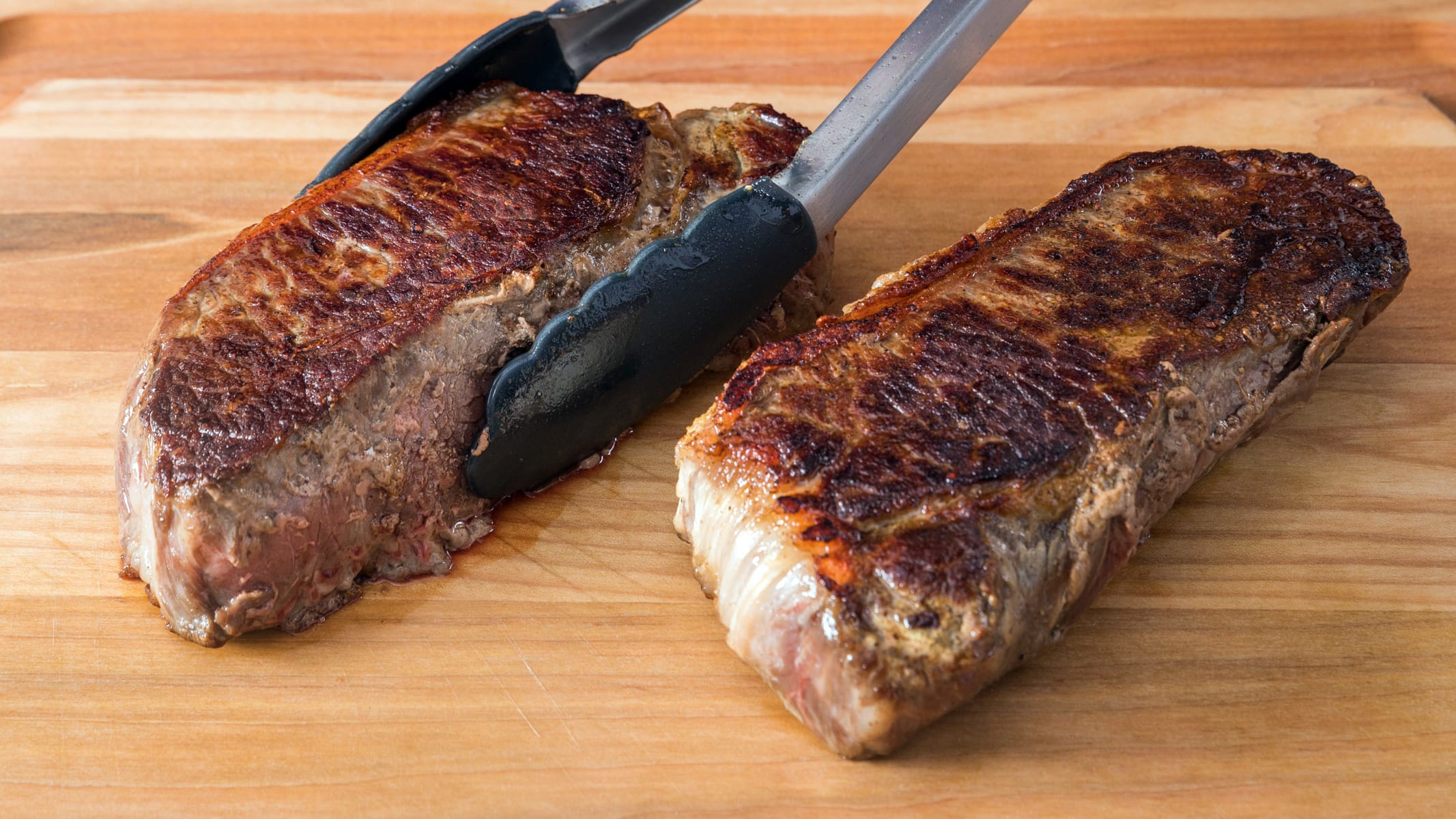Where to Sell Sey Agrd Beef
Dry-anile steak is touted as having a far more than tender texture and richer, beefier flavors than unaged beefiness. Its price—40 to 100 percent more than unaged meat—would certainly suggest a superior product. But aging times can vary significantly, from a couple of weeks to a couple of months, with some high-stop restaurants extending it every bit long as 120 days or more. Is there a minimum catamenia needed to make dry-aged steak worth the extra toll? And at what point does the process create flavors that are more of an acquired gustation? We decided to dry-age beef in the exam kitchen to answer these questions for ourselves.
How Dry Aging Works
Dry aging is basically controlled decomposition. Information technology typically starts with whole subprimals: large cuts with bones and fatty caps left fully intact. These are held in humidity-controlled refrigerated rooms where air can circulate around the beef, pulling wet from its exposed surfaces. Meanwhile, muscle enzymes in the beef slowly soften muscle poly peptide and connective tissue and change flavor, and desirable molds abound on the meat's surface, creating additional protein-snipping enzymes. At the end of aging, a thin pellicle of dried, hardened flesh will have formed on the meat'due south exterior; this, forth with the molds and oxidized fat, are trimmed away, and the beefiness is then cut into individual steaks.

Why Dry-Aged Steak Costs So Much
Betwixt moisture evaporation and the trimming away of dried moldy parts, a subprimal cut can lose more 30 percent of its original weight. This, along with the time spent in dedicated refrigerators, contributes to dried-aged beef's premium toll.
Why Dry Aging Changes Texture and Flavor
As the beef ages, water evaporates out of it, which concentrates its flavor. Meanwhile, enzymes intermission down collagen and musculus poly peptide, enhancing tenderness. The breakdown of protein and fatty likewise generates a slew of new nutty, savory, and even desirably cheesy flavors and aromas that deepen and transform the beef's taste.
How Nosotros Dry out-Aged Our Own Beef
To track beef dry-anile from two to viii weeks, we bought a fridge designed for dry crumbling. Staying at the low end of the recommended ranges, we fix information technology to 34 degrees and 76 percentage relative humidity and turned on its fans. Nosotros purchased five prime-grade prime rib roasts from the aforementioned purveyor, staggering their commitment and so that we could start aging a roast every two weeks. After 60 days, we had roasts that had dry out-aged for zilch days, 2 weeks, four weeks, half dozen weeks, and eight weeks. Nosotros trimmed each roast of desiccated flesh and some of its fat (including the oxidized portions) and then broke information technology down to create i½-inch-thick rib-eye steaks. We cooked all the steaks sous vide to 130 degrees (medium-rare) and tasted some straight from the sous vide bath (to detect flavor differences without the lark of browning) and some afterwards searing them to develop browning.

Taste and Texture of Beef Aged Two, 4, Half dozen, and 8 Weeks
- Later ii weeks of dry out aging: Steaks were barely more tender than the unaged beef and tasted very similar.
- Later 4 weeks: The meat was "melt‑in‑your‑rima oris" tender and noticeably more savory and circuitous.
- At six weeks: The beefiness was only slightly more tender than at 4 weeks, but its flavors had continued to develop, becoming more than "nutty" and "funky."
- At eight weeks: The meat was no more than tender than at half-dozen weeks, simply information technology had a "blue cheese" aroma and intensely gamy flavors with "mushroomy," "cheesy" notes that "barely resembled beef."

How to Shop for Dry-Aged Beef
Dry-anile beefiness is expensive, so you should know what you lot're buying. For our money, the sweet spot for dry aging is four to vi weeks. That'south when the meat will have become significantly more tender, with richer, beefier flavors. Only if you're up for the heightened gamy, cheesy flavors of more advanced dry aging, look for meat that'due south been aged for more than vi weeks. As for steak dry-aged for just 2 weeks—why bother? You'll be paying a lot more than for a product that'due south barely different from steak that hasn't been dry-aged.
Source: https://www.cooksillustrated.com/articles/2124-understanding-dry-aged-steak

Post a Comment for "Where to Sell Sey Agrd Beef"